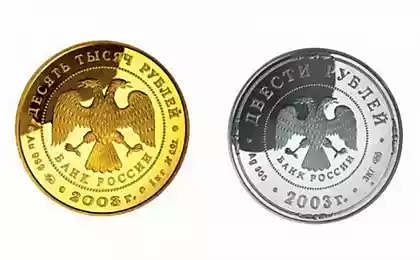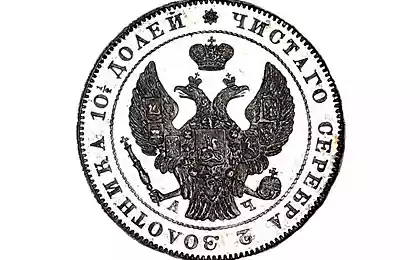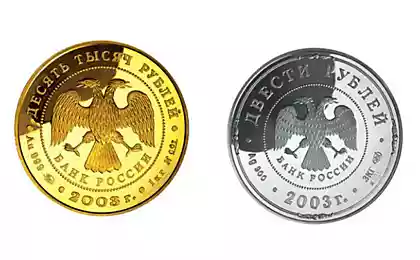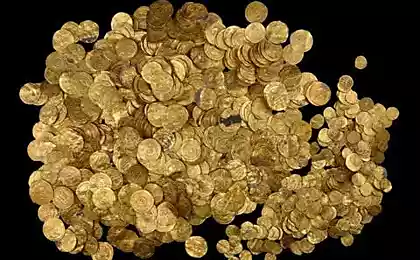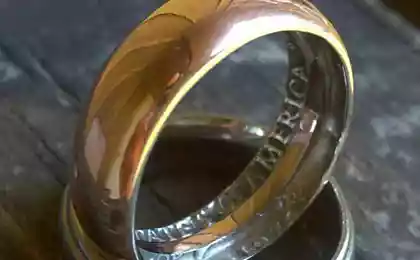1600
The most expensive coin (7 photos)
What coins are much more expensive par.
50 cents in 1929 - 10 million rubles
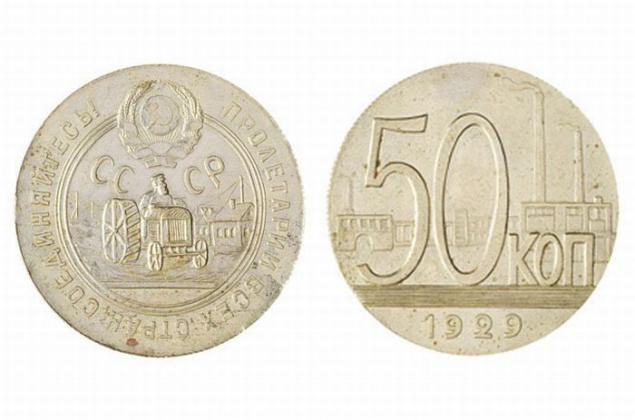
There are coins that are a solid mystery. After the collapse of the NEP, the Soviet government conceived go to the minting of copper-nickel coins instead of silver. Silver - Monetary metal - was required for the needs of industrialization. That citizens do not hoard silver detail, the reform prepared in secret (for surviving documents stands marked "Top Secret"). In 1931, the Soviet Union in circulation were copper-nickel 10, 15 and 20 kopecks. Coins 1 ruble 50 kopecks, and it was decided to no mint.
The archive of the Leningrad Mint Stamp tool survived the test of 10 and 50 cents, but not a single sample of the coins themselves. However, a few years ago in a private collection showed fifty dollars - the only known instance of a trial today coinage in 1929. In May 2011, at the auction "Znak" he was traded to the buyer to make a bet on the phone for 10 million rubles. This is a record price for Russian or Soviet coin for the last three years.
12 rubles 1836 - 4, 65 million rubles

The Russian Empire was the only country that are available for the treatment of platinum coins. Platinum 3, 6 and 12 rubles were minted from 1828 to 1845 years of fairly large editions, several thousand units per year. But some years coins known in a few instances - presumably they struck in the second half of the XIX century by order of wealthy collectors. For example, a 12-rublevok with the date 1836 was issued only eleven.
At auction, they appear very rarely and always grow in value. For example, in December 2010 at the auction house Bonhams auction of British 12 rubles 1836 "left" for $ 96,000 (about 3 million rubles). And last April the same coin at auction Moscow firm "Coins and Medals" has already sold over 4, 65 million rubles.
25 rubles 1908 - 1, 9 million rubles

At the beginning of the XX century in Siberia at the Imperial mines was found five-kilogram gold nugget. Nicholas II wanted to make him a coin for gifts relatives and in celebration of its 40th anniversary in 1908. Nugget enough for 150 gold. Later, by order of the Grand Duke Georgii Mikhailovich, a passionate collector, was coined another 25 such coins.
25 rubles 1908 are considered very rare, however, for the last year and a half they were exhibited at the Russian and foreign auctions five times. In April 2011, at the auction "Imperiya" 25-Ruble is not a better safety - with nicks and scratches - sold for 1, 9 million rubles. In excellent condition, without any damage, it would cost twice as much.
5 cents 1916 - 1, 6 million rubles
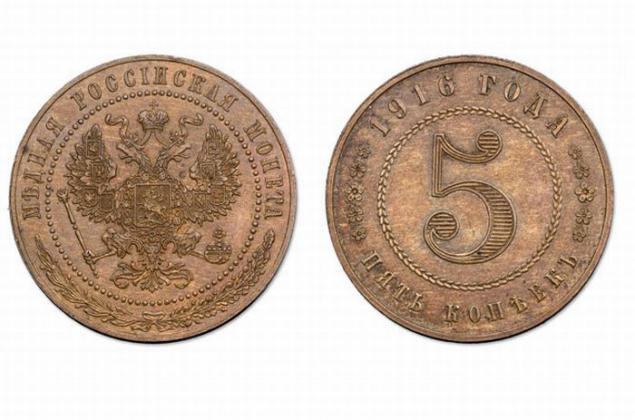
Proof coins with the date 1916 - the last witnesses and failed currency reform in the Russian Empire. During World War II, the purchasing power of the ruble fell dramatically, from circulation began to disappear, settling in "stashes" as silver and copper coins. Copper coins of the new type (1, 2, 3, and 5 cents) was supposed to do half the weight of those that were in circulation. Revolution buried this project. How much was made "probes" - unknown.
In 1927 the Leningrad Mint coined genuine stamps a certain amount of coins for sale to collectors. Nevertheless, they are still considered rare. In April of this year from 5 cents a trial series in 1916 were sold at auction "Coins and Medals" for 1, 6 million rubles. In autumn 2010, exactly the same patch of "left" sold for 1, 3 million rubles.
1 ruble 1806 - 1, 55 million rubles

Emperor Alexander I, who ascended the throne, inexplicably refused to mint coins with his portrait. Not that he did not like your own profile - known award medals with the same portraits of the monarch, and for that trial rublevikah. But they remained tentative. In the middle of the XIX century Saint Petersburg Mint produced a replica of ordered several varieties of these coins (according to the documents - not less than 30 pieces). One of them - with a portrait of Alexander I in the uniform of the Guards and an eagle on the back - on the last trading "of coins and medals", "left" for 1, 55 million rubles. If the seller bought the coin on the eve of the crisis, much lost. In 2007, the price of a "probe" reached up to 2 million rubles.
1 ruble 1705 - 1, 5 million rubles
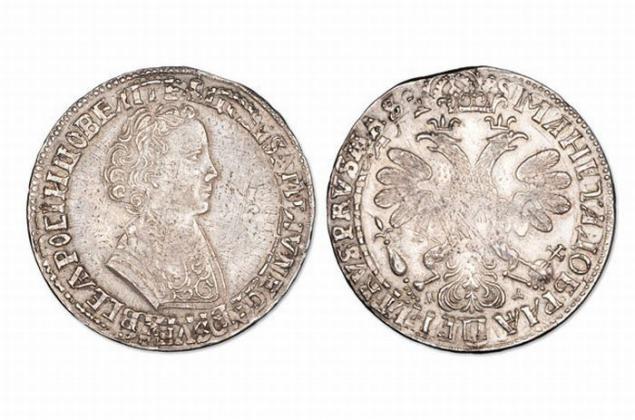
Prior to the 1730s, when they were discovered rich gold mines in the Altai, Russia did not have a silver - coins were minted from imported metal. In 1704, on the initiative of Peter I in Moscow began to produce silver rubles modeled on Western thalers. These coins were the raw material for coinage. The first time they do not happen melted, and immediately put under pressure.
At the auction, "Coins and Medals" exhibited an interesting copy of the ruble - a coin in 1705, from the Polish perechekanennaya thaler 1630 (with an error in the writing of the new date - a rare variety of stamps). Its price during the bidding rose to 1, 5 million rubles, while the ruble of the same year the ordinary coinage was sold for 400,000 rubles.
1 ruble 1861 - 1, 4 million rubles

50 cents in 1929 - 10 million rubles

There are coins that are a solid mystery. After the collapse of the NEP, the Soviet government conceived go to the minting of copper-nickel coins instead of silver. Silver - Monetary metal - was required for the needs of industrialization. That citizens do not hoard silver detail, the reform prepared in secret (for surviving documents stands marked "Top Secret"). In 1931, the Soviet Union in circulation were copper-nickel 10, 15 and 20 kopecks. Coins 1 ruble 50 kopecks, and it was decided to no mint.
The archive of the Leningrad Mint Stamp tool survived the test of 10 and 50 cents, but not a single sample of the coins themselves. However, a few years ago in a private collection showed fifty dollars - the only known instance of a trial today coinage in 1929. In May 2011, at the auction "Znak" he was traded to the buyer to make a bet on the phone for 10 million rubles. This is a record price for Russian or Soviet coin for the last three years.
12 rubles 1836 - 4, 65 million rubles

The Russian Empire was the only country that are available for the treatment of platinum coins. Platinum 3, 6 and 12 rubles were minted from 1828 to 1845 years of fairly large editions, several thousand units per year. But some years coins known in a few instances - presumably they struck in the second half of the XIX century by order of wealthy collectors. For example, a 12-rublevok with the date 1836 was issued only eleven.
At auction, they appear very rarely and always grow in value. For example, in December 2010 at the auction house Bonhams auction of British 12 rubles 1836 "left" for $ 96,000 (about 3 million rubles). And last April the same coin at auction Moscow firm "Coins and Medals" has already sold over 4, 65 million rubles.
25 rubles 1908 - 1, 9 million rubles

At the beginning of the XX century in Siberia at the Imperial mines was found five-kilogram gold nugget. Nicholas II wanted to make him a coin for gifts relatives and in celebration of its 40th anniversary in 1908. Nugget enough for 150 gold. Later, by order of the Grand Duke Georgii Mikhailovich, a passionate collector, was coined another 25 such coins.
25 rubles 1908 are considered very rare, however, for the last year and a half they were exhibited at the Russian and foreign auctions five times. In April 2011, at the auction "Imperiya" 25-Ruble is not a better safety - with nicks and scratches - sold for 1, 9 million rubles. In excellent condition, without any damage, it would cost twice as much.
5 cents 1916 - 1, 6 million rubles

Proof coins with the date 1916 - the last witnesses and failed currency reform in the Russian Empire. During World War II, the purchasing power of the ruble fell dramatically, from circulation began to disappear, settling in "stashes" as silver and copper coins. Copper coins of the new type (1, 2, 3, and 5 cents) was supposed to do half the weight of those that were in circulation. Revolution buried this project. How much was made "probes" - unknown.
In 1927 the Leningrad Mint coined genuine stamps a certain amount of coins for sale to collectors. Nevertheless, they are still considered rare. In April of this year from 5 cents a trial series in 1916 were sold at auction "Coins and Medals" for 1, 6 million rubles. In autumn 2010, exactly the same patch of "left" sold for 1, 3 million rubles.
1 ruble 1806 - 1, 55 million rubles

Emperor Alexander I, who ascended the throne, inexplicably refused to mint coins with his portrait. Not that he did not like your own profile - known award medals with the same portraits of the monarch, and for that trial rublevikah. But they remained tentative. In the middle of the XIX century Saint Petersburg Mint produced a replica of ordered several varieties of these coins (according to the documents - not less than 30 pieces). One of them - with a portrait of Alexander I in the uniform of the Guards and an eagle on the back - on the last trading "of coins and medals", "left" for 1, 55 million rubles. If the seller bought the coin on the eve of the crisis, much lost. In 2007, the price of a "probe" reached up to 2 million rubles.
1 ruble 1705 - 1, 5 million rubles

Prior to the 1730s, when they were discovered rich gold mines in the Altai, Russia did not have a silver - coins were minted from imported metal. In 1704, on the initiative of Peter I in Moscow began to produce silver rubles modeled on Western thalers. These coins were the raw material for coinage. The first time they do not happen melted, and immediately put under pressure.
At the auction, "Coins and Medals" exhibited an interesting copy of the ruble - a coin in 1705, from the Polish perechekanennaya thaler 1630 (with an error in the writing of the new date - a rare variety of stamps). Its price during the bidding rose to 1, 5 million rubles, while the ruble of the same year the ordinary coinage was sold for 400,000 rubles.
1 ruble 1861 - 1, 4 million rubles

